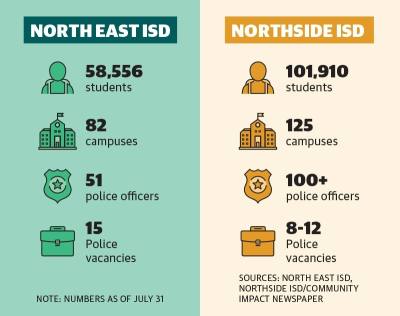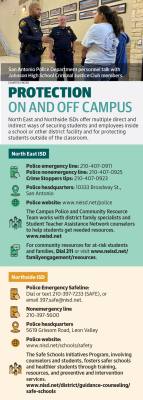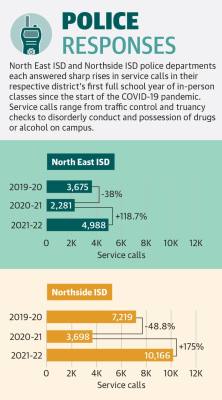Spurred by a mass shooting that killed 19 children and two teachers at a Uvalde elementary school in May, officials with San Antonio’s two biggest public school districts said they are constantly finding ways to reinforce security and safety on and off campus.
Educating a combined 160,000-plus students at 200-plus schools, Northside and North East independent school districts are slated to spend more than $15 million total on security personnel, measures and resources during this new academic year following parents and community members expressing safety concerns.
NISD is also set to spend another $18 million in newly approved bond funds to improve physical security at multiple facilities, including Colonies North and Blattman elementary schools, while NEISD has spent $20 million in bond funds within the last seven years to improve campus safety.
Statewide, the San Marcos-based Texas School Safety Center has been tasked by Gov. Greg Abbott to begin conducting random intruder detection audits at public schools as part of larger efforts to physically enhance school protections on and off campus.
NISD Police Chief Charlie Carnes said everyone has a role in fortifying campuses.
“We need the open ears and eyes of counselors, teachers, students, parents and community members to help us,” Carnes said.
Northside ISD
Carnes said he agreed with his local law enforcement counterparts that the May 24 shooting at Robb Elementary School in Uvalde CISD increased awareness of the potential for mass casualty incidents in educational settings.
But Carnes also expressed confidence that NISD is equipped to answer any school-based emergency and get help from other area law enforcement agencies if required.
“All law enforcement agencies that fall into our boundaries—we’d welcome their help,” Carnes said.
The NISD Police Department has just over 100 officers to serve a projected student enrollment of nearly 102,000 for the 2022-23 school year, in a school district that stretches from Shavano Park and Lockhill Selma Road to fast-growing far west San Antonio, Carnes said.
On average, the district has seven to eight patrol officers assigned per pod—or geographic area—of 10 elementary schools, Carnes said, adding that each high school has two assigned officers, and every middle school has one officer.
NISD has bullet-resistant security lobbies, a single-point entry at every elementary campus and more than 8,000 surveillance cameras, Carnes said.••According to NISD’s $992 million bond program that voters passed in May, the district will use $18.1 million over a yet-unspecified period to further secure district buildings by replacing fire alarm systems, door hardware and surveillance cameras as well as upgrading access controls at 19 sites
NISD previously used $34.7 million from the $849 million bond approved in 2018 to enhance doors, elementary school lobbies, and fire alarm and intercom systems, according to district documents
Meanwhile, Carnes said NISD is often shoring up different security and safety-related facets, including a summertime study of about 20,000 interior and exterior doors districtwide, a measure Texas Education Agency officials said all public school districts must complete by early September.
“Our goal is to make sure all lockable doors are working properly,” he said.
Carnes said NISD is fully informed about state-mandated and voluntary training sessions for police officers as well as different exercise drills provided for school students and employees.
Celina Bley, TSSC associate director of training and education, said the state requires public school districts to have an emergency operations plan, or EOP, that addresses a variety of potential hazards.
Bley said such plans cover emergency management, staff training and different safety drills, adding that Texas school systems must conduct security and safety audits every three years.
Bley also said every Texas public school must have a team trained to watch out for students’ or employees’ certain actions and behaviors, and assess them for the likelihood of a threat.
The EOPs are created and reviewed by each school district’s safety and security committee, which involves school leaders, staff and community members, Bley said.
“We must instill an atmosphere of vigilance,” she said.
According to state law, Texas school districts must do two lockdown drills per school year.
Carnes said students and employees must know and practice basic lockdown and lockout steps recommended by agencies, such as the TSSC, if a threat—like an active shooter—emerges on campus.
For example, Carnes said, all school occupants should stay still and quiet, especially if an armed person is inside a classroom building. He said a school’s occupants should refrain from using their phone, which may feel counter-intuitive.
“Certainly, everyone’s scared. It’s only natural. But whoever you’re calling or texting, they’re not going to be able to help you at that second. Being on the phone puts [teachers, students], possibly more at risk,” Carnes said.
Ray Galindo, NISD deputy superintendent for administration, said NISD and other school districts are weighing whether to revise active shooter exercises at elementary campuses given investigative fallout from the Uvalde shooting.
“We are having that discussion to see how that might change in the next year,” Galindo said.
North East ISD
NEISD Police Chief Wallace McCampbell said the district’s $499 million from the most recent bond approved in 2015 contained $20 million for security improvements districtwide, including perimeter fencing, secure entry vestibules, keyless access control and video surveillance. McCampbell also said NEISD would finish checking doors by early September.
McCampbell said these and other resources help him to remain confident that his department offers adequate protection and can answer any emergency. Police personnel are the first and immediate line of defense in an emergency, he added.
“You go in with what you have. You don’t have to wait for additional resources or tools to resolve the situation,” McCampbell said.
McCampbell said NEISD has more than 50 officers serving a projected student population of 58,556 in the 2022-23 school year with many officers patrolling NEISD elementary campuses.
Earlier in August, McCampbell said, NEISD added a hiring incentive, offering to cover the police academy training cost for any cadet who makes a three-year commitment with the district upon their academy graduation.
“They are just finishing some of the most rigorous training they are ever going to get. If we can get them to work for [NEISD Police Department] as soon as they graduate, they get a chance to really make a difference in the community from day one,” McCampbell said.
NEISD, NISD and other school systems are also ensuring their police officers engage with teachers and counselors to preventatively aid students struggling with mental or emotional issues.
In fall 2021, NEISD launched a campus and community resource team, on which seven non-uniformed NEISD police officers work directly to meet students’ mental health needs in a larger attempt to curb any possibility of a student becoming a threat to themselves or others.
Also, the team maintains contact with the student and their family even after officers stop regularly providing aid. The idea, McCampbell said, is to ensure there is no student relapse.
“We’re trying to be proactive,” McCampbell said.
NEISD’s risk management office also has four dedicated personnel who develop and implement programs ensuring NEISD complies with the best safety practices and state-mandated safety legislation.
David Gracia, NEISD’s risk management senior director, said a newly created but not yet filled district position of senior security and safety director will work with NEISD police and provide a focus on situational awareness and emergency training drills.
“Consequently, there is a current re-emphasizing of established safety protocols and coordinated efforts to review all facilities for safety and security,” Gracia said of NEISD.
Other resources
Aside from school systems, municipal police leaders said they also stand ready to back up school districts that have their own police force in case of an emergency, such as an active shooter situation.
San Antonio police Chief William McManus said he met with officials from area school districts in June to discuss general security matters.
Appearing in a Northside Neighborhoods for Organized Development group meeting in June, McManus said communicating with a school district’s full-time police or resource officers in an emergency is key, and so is hardening physical infrastructure at all entryways at school buildings.
“Security starts outside the building. Once they’re inside, it’s too late,” McManus said about a hypothetical armed attack.
Shavano Park Police Chief Gene Fox said his officers respond to certain calls at Blattman Elementary School and Clark High School, adding that his officers coordinate with NISD to familiarize themselves with local campus layouts.
“We’ve learned a lot about NISD’s processes and protocols,” Fox said.
Bley said the TSSC offers countless resources to school administrators, staff, police and community members. The state-mandated random intruder detection audits will help in better securing schools, Bley said.
“Everybody plays a part in school safety,” she said.











